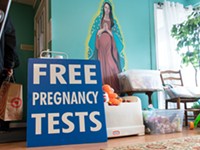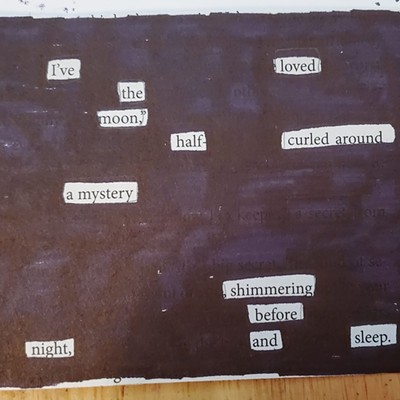Reader feedback - 5.3.06
[
{
"name": "500x250 Ad",
"insertPoint": "5",
"component": "15667920",
"parentWrapperClass": "",
"requiredCountToDisplay": "1"
}
]
SAFETY? OR A POLICE STATE?
Regarding John Klofas's recommendation to diminish violence in Rochester by following New York City's policy of making it likely that people will encounter police ("What Options for a City 'Made for Murder'?" April 19):
"All that low-level enforcement stuff meant that anybody could be stopped anytime," Klofas said. That anybody could be stopped at any time is not "low level," "enforcement," or "stuff." It is the very definition of a police state.
David E. Pell, Glen Cove Rise, Rochester
NO BETTER OPTIONS?
I found myself incredibly disappointed with the article "What Options for a City 'Made for Murder'?" (April 19). RIT Professor John Klofas was the sole interviewee, and his only answer to our city's murder problem was essentially "more judicial activity."
I understand that Mr. Klofas is a criminal-justice professor and therefore is inclined to respond in this manner, but you could have at least interviewed other specialists with other ideas. Where are those who believe that our best solution is putting more money into education and/or public programs that encourage trade or higher education, positive after-school activities, etc?
Where are those who believe that if we improve our unemployment rates (via trade programs, job-corps type programs, etc), the crime rate will decrease?
The first article in this same series determined that the main reason for exceedingly high crime rates in Rochester is a history of low income and low educational levels in our minority youth, so why not address these problems instead of just perpetuating the problem?
A plethora of scientific studies prove that stiffer penalties, higher incarceration rates, etc. do not deter crime in the long run, nor do they rehabilitate those who have committed crimes in the past (who are the most likely to commit crime again). Why are we not addressing and curing the issue at its root, but are simply putting ineffective Band-Aids on the result? That's about as effective as putting a Band-Aid on an ulcer in hopes that it will heal. It might, but it's more likely to develop gangrene.
Unique Lee, Rochester
SLAVERY'S IMPACT
I generally enjoy reading interviews with RIT criminologist John Klofas ("Made for Murder," April 12 and 19). I was dismayed however, that his interview on the causes of the high murder rate in Rochester did not mention the influence of slavery on differences in the homicide rates of African-Americans and Hispanics.
The institution of slavery criminalized literacy. It also seems to me that plantation owners, through their sexual activity and slave transactions, contributed significantly to the current prevalence of matriarchal families among African-Americans.
Linda Phillips, Greenaway Road, Brighton
TAXING EQUITY
Now that tax time has passed, I wonder how many New Yorkers realize how distorted the state income-tax rates are.
People with very low income levels pay at a rate of 4 percent. The rate progresses to a maximum of 7.7 percent at incomes of over $500,000. Individuals have no personal exemption for themselves. Therefore, the 4 percent rate is taxed on the very first dollar after either the standard or itemized deduction.
While there are personal deductions for dependents, they are at the 1970's level of only $1000 each, compared to the 2005 federal exemption of $3200. Unfortunately, New York does not seem to index for inflation, creating a more onerous burden each year for those at the bottom of the income scale.
There is a household credit which can reduce taxes for the very lowest payers. But since lower-income individuals and families also pay a disproportionate amount of their income in sales tax, they face a much higher tax burden proportionally than those who are well off. It is no surprise that people are leaving New York!
It would seem much fairer if people were able to keep some income as a result of a reasonable personal exemption, and if rates at the low end were immediately adjusted downward and then indexed to reflect inflation. Otherwise, New York will look like the America of the motion picture, "Soylent Green," where there are a few super rich and everyone else lives in poverty.
Jeff Baker, Perinton
LOST OPPORTUNITY
"Rail to Trail" (March 15) left readers with the impression that the urban trail project would be a real win for the area. However, that story missed the bigger picture and the true opportunity cost of this surprisingly low-impact, limited-appeal project.
As well-intentioned as Tom Frey and his colleagues appear to be in bringing green space to disadvantaged areas of the city, the glaring reality is that these areas are in far greater need of economic development. Unfortunately, a recreational trail will have negligible impact in terms of economic uplift for the areas touched by the corridor. Coincidentally, we must hope that an improved trail won't simply provide a nicer locale for the crimes and mischief that have already occurred on this currently unmaintained property.
Am I biased in my opinion? Absolutely. I worked for several years to convert the former freight rail corridor into a low-speed passenger rail corridor that would transport people between downtown Rochester and Charlotte, with stops along the way at places like SenecaPark and other points of interest. As a public-private partnership, Rochester Trolley & Rail has worked to create connections between otherwise disconnected destinations in our community, using historic, rail-based trolleys. Economic impacts would include job creation, local investment in infrastructure, and a renewed sense of pride in the areas traveled by the trolley.
Admittedly, the prime motivator behind this phase of our project was to connect the Fast Ferry terminal with downtown for passengers who came without cars, a likelihood for people who would have come over from Toronto. Obviously the hope and opportunity around the ferry has faded into oblivion, though the value in connecting Rochester's neighborhoods and activity centers has not, and increased mobility for residents and visitors alike cannot be undervalued.
Our community's need to create robust connections between downtown Rochester, Irondequoit, and Charlotte is as strong as ever. With an urban-suburban dichotomy that continues to permeate so much of Greater Rochester, we desperately need to create lasting connections --- and faster than can ever be accomplished solely by foot or bicycle.
Unfortunately, our efforts to integrate with the proposed trail effort were largely ignored or dismissed, as were the very real synergies that a joint approach made possible. Although recreational trails don't create jobs and trail users don't spend money supporting neighborhood businesses as part of their trail usage, apparently an urban trail was all that mattered as the discussions unfolded.
Regrettably, the trail effort was conducted without broad public awareness, notice, or comment. As members of the broader community, we are right to ask: "Where were the opportunities for true public input? Where were the stakeholder meetings?" Sadly, because the "big-picture" perspective was omitted, these opportunities for broader input and synergies were too.
At this point, only one description befits the decision to use this precious corridor for a trail (and only a trail): economic waste. What is promoted as "good" for a few neighborhoods (and a very small sub-segment of Rochester's population) is frankly an insult to the rest of the community.
Christopher Burns, Irondequoit (Burns is president and CEO of Rochester Trolley & Rail Corporation.
WRITING TO CITY
We welcome and encourage readers' letters for publication. Send them to: [email protected] or The Mail, City Newspaper, 250 North Goodman Street, Rochester14607.
Our guidelines: We don't publish anonymous letters --- and we ask that you include your street name and city/town/village. We don't publish letters that have been sent to other media --- and we don't publish form letters generated by activist groups. While we don't restrict length, letters of under 350 words have a greater chance of being published. We do edit letters for clarity and brevity. And in general we don't publish letters (or longer "op-ed" pieces) from the same writer more often than about once every two months.




